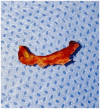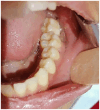Aspergillosis Osteomyelitis of the Mandible: A Case Report and Literature Review
- PMID: 40519329
- PMCID: PMC12161888
- DOI: 10.1177/30502098251344770
Aspergillosis Osteomyelitis of the Mandible: A Case Report and Literature Review
Abstract
Aspergillosis is an uncommon fungal infection caused by Aspergillus species, predominantly affecting immunocompromised individuals. While pulmonary involvement is common, extrapulmonary manifestations such as osteomyelitis are uncommon. Aspergillus osteomyelitis of the mandible is an exceptionally rare and life-threatening condition, posing significant diagnostic and therapeutic challenges. We present the case of a 13-year-old immunocompromised patient diagnosed with this condition. The patient presented with persistent jaw pain, swelling, and radiographic evidence of extensive bone destruction. Diagnosis was confirmed through fungal cultures and histopathological examination, which identified Aspergillus species. The patient underwent surgical debridement and prolonged antifungal therapy, leading to clinical improvement. Aspergillus osteomyelitis of the mandible is exceedingly rare, with only a few cases reported in the literature. Early diagnosis is crucial to prevent further bone destruction and associated complications. This case underscores the importance of considering fungal infections in the differential diagnosis of osteomyelitis, particularly in at-risk populations. It also emphasizes the potential role of antifungal prophylaxis in reducing the severity of invasive fungal infections when they occur. Managing this condition presents significant challenges, including the need for aggressive antifungal therapy and the risk of recurrence.
Keywords: Aspergillus osteomyelitis; bone destruction; case report; fungal infection; immunocompromised; mandible; treatment.
© The Author(s) 2025.
Conflict of interest statement
The author(s) declared no potential conflicts of interest with respect to the research, authorship, and/or publication of this article.
Figures










Similar articles
-
A Rare Case of Mandibular Aspergillus Osteomyelitis in an Immunocompetent Patient.Dent J (Basel). 2022 Nov 9;10(11):213. doi: 10.3390/dj10110213. Dent J (Basel). 2022. PMID: 36354658 Free PMC article.
-
Aspergillus granulosus femoral osteomyelitis in a cardiac transplant patient: first reported case and literature review.Ther Adv Infect Dis. 2024 Feb 14;11:20499361241231482. doi: 10.1177/20499361241231482. eCollection 2024 Jan-Dec. Ther Adv Infect Dis. 2024. PMID: 38361916 Free PMC article.
-
Aspergillus Osteomyelitis of the Ribs in Immunocompetent Hosts: Report of Two Rare Cases.J Orthop Case Rep. 2017 Jul-Aug;7(4):61-64. doi: 10.13107/jocr.2250-0685.854. J Orthop Case Rep. 2017. PMID: 29181357 Free PMC article.
-
Fungal osteomyelitis after arthroscopic anterior cruciate ligament reconstruction: a case report with review of the literature.Knee. 2012 Oct;19(5):728-31. doi: 10.1016/j.knee.2011.10.007. Epub 2011 Dec 30. Knee. 2012. PMID: 22209694 Review.
-
Aspergillus osteomyelitis: epidemiology, clinical manifestations, management, and outcome.J Infect. 2014 May;68(5):478-93. doi: 10.1016/j.jinf.2013.12.008. Epub 2013 Dec 27. J Infect. 2014. PMID: 24378282 Free PMC article. Review.
References
-
- Denning DW. Global incidence and mortality of severe fungal disease. Lancet Infect Dis. 2024;24(7):e428-e438. - PubMed
-
- López-Cortés LE, Garcia-Vidal C, Ayats J, et al. [Invasive aspergillosis with extrapulmonary involvement: pathogenesis, clinical characteristics and prognosis]. Rev Iberoam Micol. 2012;29(3):139-143. - PubMed
-
- Gabrielli E, Fothergill AW, Brescini L, et al. Osteomyelitis caused by Aspergillus species: a review of 310 reported cases. Clin Microbiol Infect. 2014;20(6):559-565. - PubMed
-
- Cho H, Lee KH, Colquhoun AN, Evans SA. Invasive oral aspergillosis in a patient with acute myeloid leukaemia. Aust Dent J. 2010;55(2):214-218. - PubMed
Publication types
LinkOut - more resources
Full Text Sources
